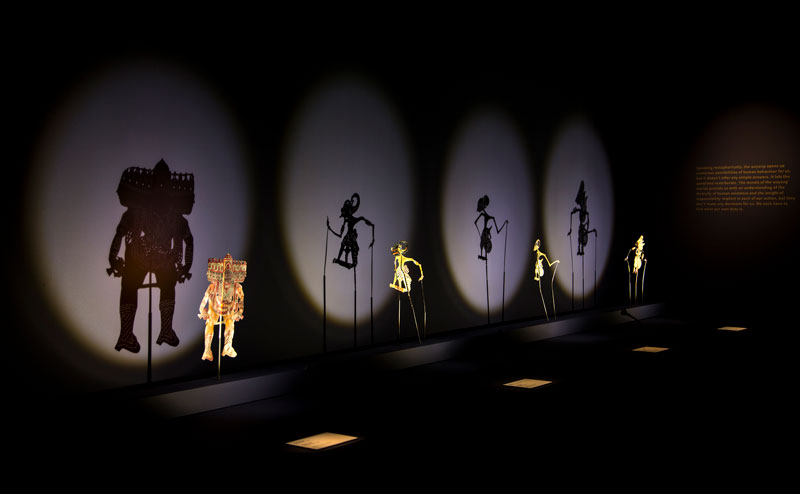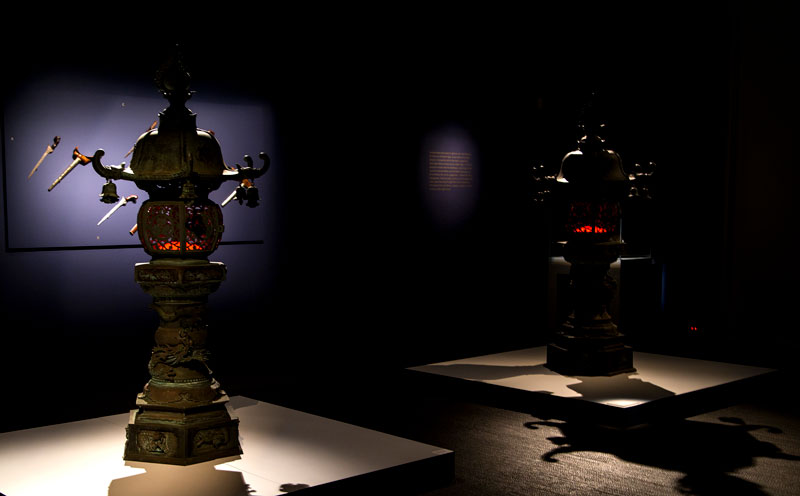.jpg)
In a conventional performance of shadow puppetry, a screen separates the puppet from its shadow. But in the dramatically darkened interior of the Holmes a Court wing of the Lawrence Wilson Art Gallery, the object and its reflection stand together in a way that you could never see at a performance. This exhibition is not an esoteric excursion into antiquity: it is a display of living traditions with objects that are both historical artefacts and, simultaneously, art works which have current ritual or cultural usage. This exhibition is visually challenging; it teases us with hints and questions about the provenance of the works.
Like the entry to the exhibition, its title riffs off the Javanese term Wayang Kulit, the ancient art of shadow puppetry, which lives on in Indonesia and more sporadically in other parts of Southeast Asia and India. Wayang is at once an everyday word for any theatrical performance and also means image, imagination, reflection. In a Wayang Kulit performance the puppet master, dalang, guides the audience through shadows on a screen bringing to life the well-loved ancient Indic epic tales, always inflected with contemporary and local concerns. This puppetry is no child’s play: performances can be intensely political, even dangerously so, when the master puppeteer mobilises drama and humour to question authority, power and hierarchy.
American artist Martha Keller wrote of her first experience of shadow puppets (Ann Arbor News, 1988): “Javanese painted puppets cut from leather cast shadows on a small 4 x 7 screen: Sounds simple enough, but this is sophisticated shadow painting, a ‘moving visual display,’ a great art form … The symphonic magic can be watched from either side of the screen over a time span of several hours to all night … Members of the audience can come and go as they please … and can, in fact, check out both sides of the split realm, the bifurcated world of the shadow screen.” But mostly audiences watch the shadows. The reflection is more material to the drama than the intricately decorated, formally precise leather cut-outs, back-lit these days by an electric lamp.
The curator could have acted as the dalang providing detailed commentary on the imagery at play. But Sarah Ridhuan lets the objects set within darkness illuminate themselves with the most minimal lighting and notation. Sarah grew up within what she calls “a Malay/Muslim” culture. Later, as a student of anthropology, she discovered the diverse range of Indo-Pacific traditions, which are less normative and more discursive than the highly prescriptive Abrahamic religions, such as Islam and Christianity. Challenging the dichotomy of light and shadow, and the host of metaphors that depend on that physical divide – black and white, good and bad, right and wrong, even past and present (when we speak about shadowy pasts vs clear, present-day perspectives). This became the basis of Ridhuan’s first curatorial venture. A selection of objects from the Berndt’s Asian collection helped scuttle these ethical and aesthetic divisions as mutable and erratic.

The current exhibition in the Holmes a Court Gallery, which since 2012 has mounted several exhibitions from the Berndt Collection, draws on a small but significant element of Ronald and Catherine Berndt’s personal collection, and later acquisitions of the Berndt Museum. The Kalighat Paintings, four of which form part of this exhibition, deserve some historical commentary. The Kalighat temple complex is a holy shrine of Hindus, located at the southern end of Kolkata (once the capital of British India and now the provincial capital of West Bengal) on the banks of the River Ganges. Artefacts signifying religious icons were probably a common part of the pilgrim trade here, since at least the early 1700s when the complex in its current configuration was established. By the nineteenth century a substantial traffic of local worshippers, South Asian pilgrims and foreign tourist provided for a thriving market for souvenirs and memorabilia.
The Kalighat School of painting came into its own incorporating Western forms and sensibilities into what had been a traditional, rural, craft of the local area. Located at the cross-roads of the religious and the secular, folk art remade with new techniques, Kalighat paintings are seen by many historians as a starting point of modern art in Bengal. By the early twentieth century, cheaper lithograph reproductions killed off the market for religious paintings – and the so-called Kalighat School all but disappeared by the 1930s, leaving behind a stylistic legacy for the next generation of urban, and formally educated artists. With 645 of these watercolours, London’s Victoria and Albert Museum has the largest collection. There may be just a few hundred others distributed across several museums and galleries in India and Britain. There are reportedly 46 in the Berndt Museum – making it one of the larger of the known institutional collections of this important regional heritage.

From an historical point of view, the current exhibition is embedded in ancient, pre-colonial histories of the Indo-Pacific. As Hinduism and Buddhism were transported from mainland South Asia through the islands in the Indian Ocean and up North across the mountains, they intermingled with local cultures and produced new stories, myths, crafts and artistic interpretations. Stories of Ramayana and Mahabharata and the Buddhist Jataka tales were told in many forms in many places right across the region. These networks of common mythology that connect the nations to Australia’s north come into view as you move past the Javanese Wayang figures, Lord Krishna and the Pandawa brothers Yudhistira and Bima, to the flatter, less delicate Ravana from Andhra Pradesh, India, then stop in front of the massive Balinese sculpture of the same Demon King capturing Sita, the hapless heroine of Ramayana, possibly the oldest epic on earth. In the centre of the room two massive Japanese lanterns cast just enough light to guide you in, as they might have lit the way for the pilgrims from one Buddhist shrine to another, since time immemorial.
The catalogue brochure starts with a quote from Jung: “How can I be substantial if I do not cast a shadow? …” Perhaps any discussion of shadows in an Anglo–European cultural setting turns inevitably to Jung. But, for me, Jung sits uneasily here. For Jung, in the end there is the substantive, more real thing of “I” or “we” that casts the shadow. But the Hari–Hara painting from the Kalighat School makes no such distinction between the light Hari and the dark Hara, they are one and the same as the accompanying text points out: “Vishnu is the heart of Siva and likewise Siva is the heart of Vishnu.” Essential unity of apparent binaries is a common thread in Hindu–Buddhist spirituality and aesthetics, which live on across the Indo-Pacific.
.jpg)
The Kalighat paintings and the figurines from Tibet and Nepal all in one way or another play on this deep sameness that underlies, and ultimately belies, all visible difference. Finally, the fine gold paint on black Japanese lacquerware in one discrete corner of the room returns us most directly to the notion that darkness is an essential component of seeing: “Lacquerware decorated in gold is not something to be seen in a brilliant light, … it should be left in the dark, a part here and a part there picked up by a faint light,” writes the famous Japanese novelist Jun’ichiro Tanizaki in his essay “In Praise of Shadows.”
Once objects collected by anthropologists used to be stored in museums, regarded as the rightful place for the ancient, the archaic, the residual. By contrast, art galleries have long been the valorised site for more experimental and contemporary work – the place to break traditions. In recent years, many institutions including the Lawrence Wilson Art Gallery and the Berndt Museum have been chipping away at this particular border dispute. This exhibition is one such example as an invitation to look into religious representations from the past through the guise of the more secular present enabling us to appreciate as well as question the pleasure and politics of difference.












